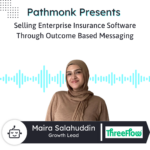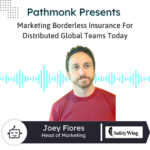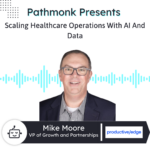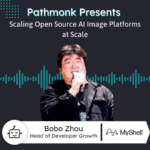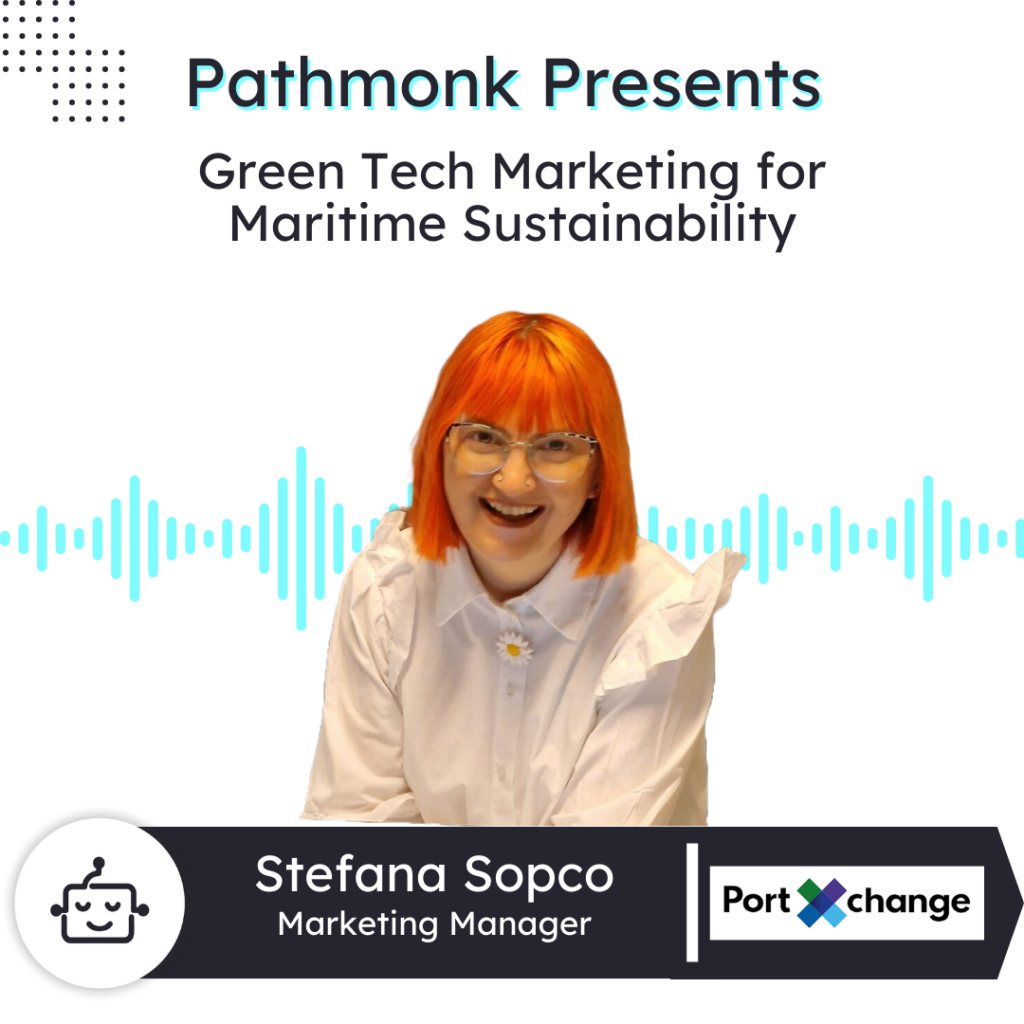
Introduction
In this episode, we welcome Stefana Sopco, Marketing Manager at Port Xchange, a green tech company developing digital solutions for predictable and sustainable shipping.
Stefana shares insights on Port Xchange’s mission to pave the way for zero-emission ports and their focus on sustainability. She discusses the challenges of marketing in the traditional maritime industry, the importance of thought leadership, and effective B2B marketing strategies. Stefana also offers valuable advice for marketers, including the significance of networking, personal branding, and investing in content distribution to drive brand awareness and lead generation in the B2B space.
More Sales From Your Website With AI
Personalized interactions based on your users' behaviour to get +50% more conversions.
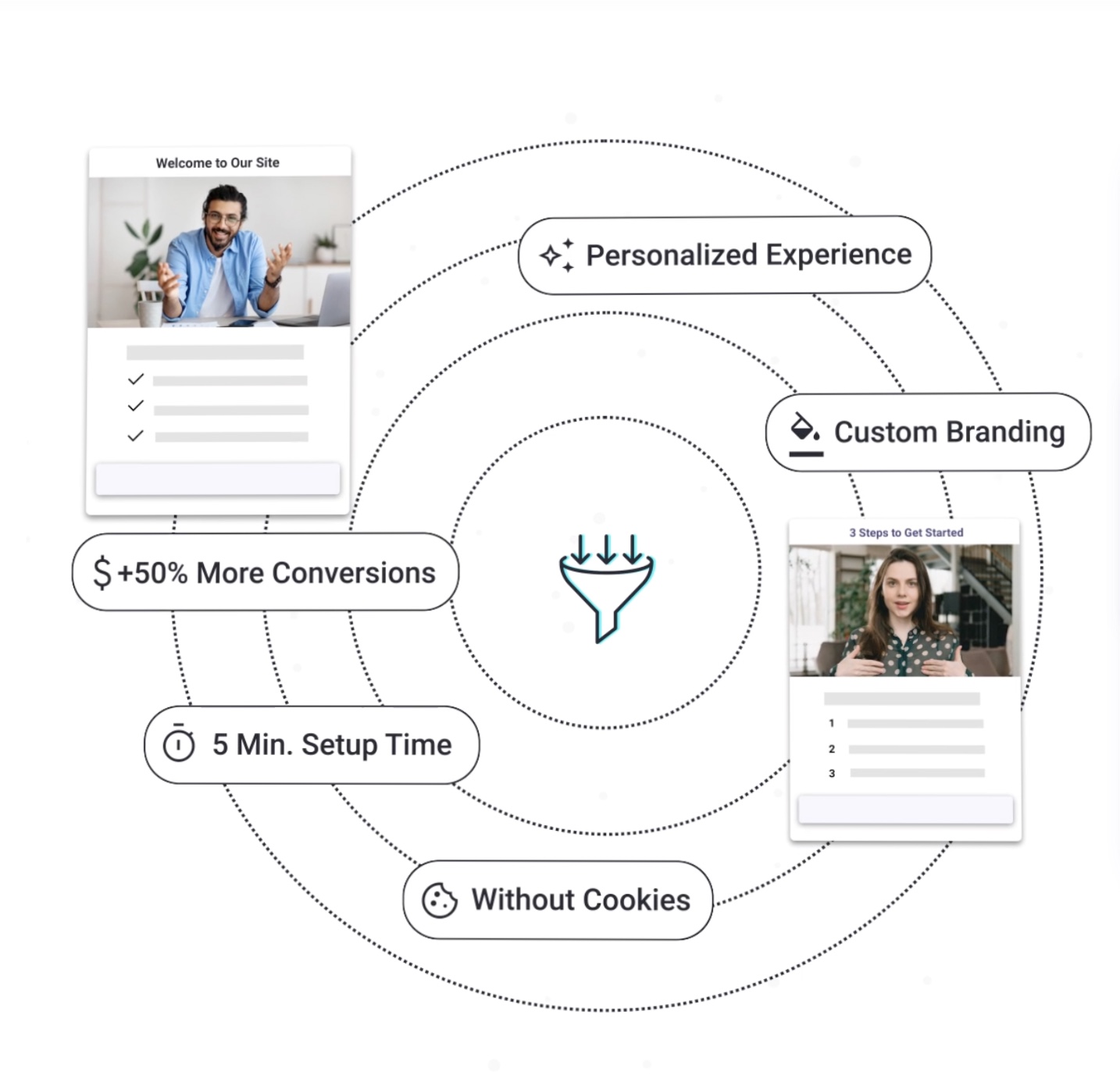
Ernesto Quezada: Pathmonk is the intelligent tool for website lead generation. With increasing online competition, over 98% of website visitors don’t convert. The ability to successfully show your value proposition and support visitors in their buying journey separates you from the competition online. Pathmonk qualifies and converts leads on your website by figuring out where they are in the buying journey and influencing them in key decision moments. With relevant micro experiences like case studies, intro videos, and much more, stay relevant to your visitors and increase conversions by 50%. Add Pathmonk to your website in seconds. Let the AI do all the work and get access to 50% more qualified leads while you keep doing marketing and sales as usual. Check us out on pathmonk.com. Welcome to today’s episode. Let’s talk about today’s guest. We have Stefana from Port Xchange, marketing manager with them. How are you doing today, Stefana?
Stefana Sopco: Hey, Ernesto. I’m really good. Thank you so much for having me.
Ernesto: It’s great to have you on today’s show, and, well, I’m sure listeners are tuning in wondering what Port Xchange is all about. Who’s Stefana? So, give us a little bit of an intro there for us.
Stefana: Thank you so much. Well, let me start by giving you a little bit of an introduction to who I am. I am the marketing manager at Port Xchange. I’ve built a marketing career of more than twelve years now. In the last six years, I worked in the B2B SaaS environment in the Netherlands, where I live as an expat. I dedicated the past four and a half years to more traditional industries like tank storage, the energy industry, and the maritime industry, which earned me two times 40 under 40 awards by Tank Storage Magazine. I’ve also been named one of the top 100 tank storage influencers in the world by Storage Journals Magazine, and I’ve been a Responsible AI Leader nominee by Women in AI Netherlands. Next to my role at Port Xchange, I’m also the marketing manager and spokesperson for Women in Tech Netherlands. I’m an SEO and content contributor for Zhok Studio, a content marketing agency, and I’m also a marketing consultant for various companies like Dearly, for example.
A little bit about Port Xchange, which is very exciting because I’ve just started as the market manager there for a month and a half. Port Xchange is a green tech company based in Rotterdam, the Netherlands. We’re developing digital solutions for predictable and sustainable shipping. Sustainability is a very important pillar for me, and among our products, we pride ourselves on Emission Insider, which is a digital solution that helps ports track and analyze emissions in and around the port to develop an actionable decarbonization strategy. I hope that’s clear enough.
Ernesto: Yeah, definitely. I mean, and so that way, our listeners who are tuned in, Stefana, could go ahead and get a good understanding of Port Xchange. What would you say then is the key problem that you guys like to solve for clients?
Stefana: So, as you could tell already, we work with ports worldwide, from Port of Rotterdam, where I’m based, to Port of Houston, from Europe to the USA, to Asia, you name it. Our main mission is to pave the way to zero emissions ports. Port Xchange Emission Insider, the product that we are most focused on marketing, empowers ports to make better decisions to eliminate emissions from ships, trucks, and rail. In that sense, we help ports track, analyze, and report Scope 3 emissions. A whole story there, but Scope 3 emissions are now becoming mandatory to report through a new regulation that is named CSRD. A very, very complicated matter there, actually.
Ernesto: All right, awesome. Good to hear that. I mean, you did mention you guys work with the Port of Rotterdam and the Greater Houston Port, but I still see that you guys work with Shell. So, I mean, is there a certain vertical that you guys like to go for? Would the ports be the ideal ICP for you guys, or is there another type of segment that you guys like to go for?
Stefana: Correct. Right now, we are mainly focusing on ports, especially because we are very focused on sustainability matters and emissions reporting. Ports are currently our ICP.
Ernesto: Perfect. Okay. And so then, how would these ports usually find out about Port Xchange? Is there a top client acquisition channel for you guys?
Stefana: It’s quite interesting to mention here. We are active in a very traditional industry. The maritime industry is still quite traditional. So in that sense, we’re trying to combine various activities. Our main acquisition channels, as of now, are offline events. I just returned from Paris, where I was at a conference, for example. Magazines are still quite valuable for us. Speaking engagements—the moment we are positioned as a thought leader on a stage. Media partners—we work with many media partners. PR releases, strategic partnerships as well with industry-related organizations, and in general, media outlets that have already established themselves within the industry. And then, we are positioning ourselves quite strongly on LinkedIn, newsletters, and our website. There’s also a new concept that I like, using it personality-led content. I’ve been trying to leverage personality-led content for a while, basically using my own voice and my own personal brand to put content out there for educational purposes.
Ernesto: Definitely. Okay, great to hear that from the company and yourself. And so that way, our listeners who are tuned in could go ahead and visit you. They could always check you out at portxchange.com. What role does the website then play for client acquisition?
Stefana: Wonderful. Yes. That is very interesting for us. As of now, our website is a knowledge hub. Its main role is to educate and position our colleagues, our team, as thought leaders within the industry. Given that the maritime industry is still quite traditional, gaining trust is a priority. Our website is mainly used for brand establishment and awareness. In the past, before I joined, there has been little conversion achieved through the website, especially organically. And now one of my main priorities is to transform the website into a lead generation machine, first of all, by eliminating as much friction as possible. But as you know, because you’ve been in this industry for a while, it will require a long-term content strategy and lots of consistency.
Ernesto: Definitely important. Okay, awesome. Thank you so much for sharing that. And on that note then, you mentioned it’s more of a knowledge hub, but would there be any rules or tips or methods that you would recommend to our listeners as far as website lead generation?
Stefana: Yes. Like I’ve mentioned, I’ve been in the B2B industry for a while now, even before I moved to the Netherlands. So in total, it’s eight years plus. And one thing that I’ve learned throughout these years is to ungate content. As much as we like gating content, MQLs are not as relevant as the number of leads generated. It is basically irrelevant as long as your influence marketing revenue numbers are low. At least for me, that’s how I measure ROI and KPIs, etc. After twelve years of marketing and eight years in B2B, one thing I know for sure is that decision-makers in 500+ employee companies won’t submit their contact info to get a white paper. There’s no way you will see them doing that. What I’ve been doing, and it worked quite well in the last couple of years, was to invest in valuable content and offer as much as possible content for free. Eliminate friction. Nobody cares about six-step follow-up sequences. In my opinion, they are quite spammy. I’ve seen backlash from this. Most of the hot leads that download the white paper or submit the form to a webinar will follow up themselves if they are in the buying mode.
Another thing that I invest a lot of time in is word of mouth. And if you engage your content on the website and you use tools like Leadfeeder, for example, to keep an eye on who visits your website and consumes your content, and then you make it personal, leveraging LinkedIn and building relationships. And another important thing that I’ve been working on is making sure that our content is not buried in more content. I would like to see marketers being mindful of internal link building as well as old content optimization. You know how people constantly say content is king? I say distribution is king. So investing in distribution, definitely.
Ernesto: Okay, important. Thank you so much for sharing those tips and methods with us, Stefana. Well, let’s switch gears a little bit then and let’s talk about you as a leader. You mentioned you’ve been there for a month and a half, but it sounds like you’re coming in strong to Port Xchange. What are some key tasks you’re focused on in your day-to-day work currently?
Stefana: Content distribution, first of all. Leveraging different channels, leveraging different methods to bring content in front of our industry. There’s absolutely no value in creating super good content every day if you have no distribution strategy in place. I’m very busy building a machine for brand awareness right now. Port Xchange needs to be highly marketed within the industry where we are active. Managing projects and partnerships—I think that’s probably what takes most of my time, building relationships with key people within the industry. Today, for example, was a full day of follow-up. Coming back from the conference in Paris, I’ve had to do lots of follow-up there. On a day-to-day basis, I work on website optimization. Like I mentioned, I’m accelerating brand recognition. I’m looking for the best events to participate in, and I’m creating content every day for my personal LinkedIn and for our business page on LinkedIn.
Ernesto: Great to hear that. So, in the between times, I mean, you already have tons of experience, but how do you stay up to date with all the news in the marketing world as far as trends, strategies? Is there a preferred channel that you like to go with?
Stefana: My preferred one for learning is actually the LinkedIn learning space. I enjoy micro-learning. I think that works best for me. I also curate my LinkedIn feed to make sure I only get what interests me. It’s a combination of marketing-related information and maritime industry-related information. I read a lot. I prefer books to videos anytime, actually. And I go to events and conferences. It’s super exhausting, mega rewarding, though, especially if you want to expand your network and hit two bunnies at the same time—learn and network.
Ernesto: Awesome. Great to hear that from you. Thanks for sharing that. Well, let’s jump into our next section here, Stefana, which is our rapid-fire question rounds. Are you ready for that?
Stefana: Yep, yep, yep.
Ernesto: All right, perfect. Awesome. So first off, Stefana, what is the last book that you read?
Stefana: Awesome. I was super excited for this question because I have two books that I’ve recently finished. The most recent one is Everybody Matters: The Extraordinary Power of Caring for Your People Like Family by Bob Chapman and Raj Sisodia—I hope I pronounced that correctly. And the other one is What You Do is Who You Are: How to Create Your Business Culture by Ben Horowitz. This one was actually recommended to me by my manager and CEO of Port Xchange. Really, really good one. Thank you for borrowing the book as well.
Ernesto: Definitely. Great reads there for our listeners. Next up then, is if there were no boundaries in technology, what would be that one thing that you would want to have fixed for your role as a marketer today?
Stefana: Yes. So I think I’ve answered this question the same in the past eight years. It would be creative design and video design. Too many companies underestimate having this in-house talent. Design is not my strength. Having an internal creative designer or at least access to tools that have the capability to create brilliant designs with little effort would be amazing. There are many AI tools right now, but the quality is not the best, and the outcome is not what you would normally go for. I think my biggest dream as a marketing manager is to have an internal creative team or at least a suite of tools that match that level of talent.
Ernesto: Great. Like you mentioned, that hasn’t changed, right? So it’s always there for you.
Stefana: Yeah.
Ernesto: On that note then, if there’s one repetitive task that you could automate, what would that be?
Stefana: Following up with external partners on deliverables, of course. This is my new mantra, I think. I’m tired of how many follow-up messages I have to send. Secondly, it would be personalized messages on LinkedIn, because as of now, no automated tool that I’ve used has done the job. They’re all buggy, robotic, and spammy. I would not recommend anyone automate their messages on LinkedIn with the tools that at least I’ve tested. As of now, I have a little 6th sense for spotting automated messages from miles away. So, I think these would be the ones that I’m still looking for a solution or a magic wand for.
Ernesto: Okay, awesome. Good for you. And then, well, lastly, Stefana, I mean, you have the experience, right? But what would be that one piece of advice that you would give yourself if you were to restart your journey as a marketer today?
Stefana: Yeah. Invest in growing your network, especially if you are a B2B marketer. Nothing beats connections. Nothing beats personal relationships. Websites die. Algorithms change every month. Platforms crash. Personal relationships can be forever. Invest in your personal brand. Do not work for companies that won’t allow you to establish yourself as a thought leader or to build your personal brand. Run away from them. These are my major lessons ever since I started my career.
Ernesto: Great. Some great advice there, not just for you, but for all our listeners. Thanks so much for sharing that. Well, we are coming to the end of today’s episode, Stefana, but before we do end, I do want to give you the last word. If someone forgets everything about the interview today, what is that one thing they should remember about Port Xchange?
Stefana: Scope 3 emissions. Reporting net zero by 2050 cannot be achieved without the proper technology. I would very much like to be one of the top leaders within the industry, and that’s why I actually joined Port Xchange. So I’m really, really excited about that. Thank you so much, Ernesto, for giving me this opportunity to speak about it.
Ernesto: No, thank you so much, Stefana, for being on with us as well. I want to thank our listeners for tuning in, and I’m looking forward to our next episode at Pathmonk Presents. Thanks a lot, Stefana.
Stefana: Thank you, Ernesto.




